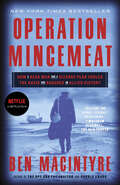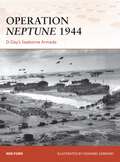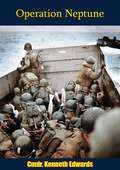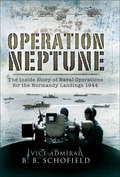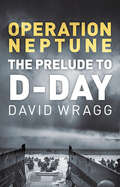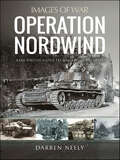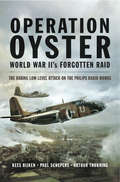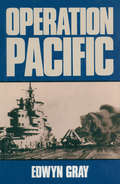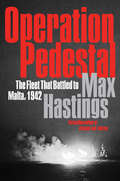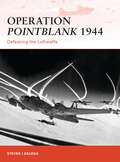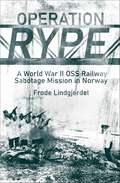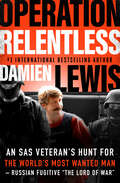- Table View
- List View
Operation Mincemeat: How a Dead Man and a Bizarre Plan Fooled the Nazis and Assured an Allied Victory
by Ben MacintyreNEW YORK TIMES BESTSELLER • NOW A NETFLIX FILM STARRING COLIN FIRTH • The &“brilliant and almost absurdly entertaining&” (Malcolm Gladwell, The New Yorker) true story of the most successful—and certainly the strangest—deception carried out in World War II, from the acclaimed author of The Spy and the Traitor &“Pure catnip to fans of World War II thrillers and a lot of fun for everyone else.&”—Joseph Kanon, The Washington Post Book WorldNear the end of World War II, two British naval officers came up with a brilliant and slightly mad scheme to mislead the Nazi armies about where the Allies would attack southern Europe. To carry out the plan, they would have to rely on the most unlikely of secret agents: a dead man.Ben Macintyre&’s dazzling, critically acclaimed bestseller chronicles the extraordinary story of what happened after British officials planted this dead body—outfitted in a British military uniform with a briefcase containing false intelligence documents—in Nazi territory, and how this secret mission fooled Hitler into changing military positioning, paving the way for the Allies&’ drive to victory. NAMED ONE OF THE BEST BOOKS OF THE YEAR BY THE NEW YORK TIMES
Operation Moonlight: A compelling and emotionally moving historical fiction novel
by Louise MorrishPassion, war and deadly secrets . . .'A charming novel full of fascinating detail about the Second World War, AND a heart-warming love story. I loved every word of it!' Katie Fforde'Wonderfully moving. A book to curl up with' Fern Britton'I absolutely loved this heart-warming story' Susan Lewis'Enthralling from beginning to end' Alan Titchmarsh'Well researched and extremely moving. I really enjoyed it' Jill Mansell____________WARTIME FRANCE, 1944Trust absolutely no one.This is the only advice newly recruited SOE agent Elisabeth Shepherd is given when faced with the impossible.Her mission: to enter Nazi-occupied France and monitor the Germans' deadly long-range missiles.GUILDFORD, 2018Betty is celebrating her 100th birthday when she receives an invite from the Century Society to reminisce on the past.She remains mysteriously tight-lipped about her past, however.And then her carer, Tali, discovers a box full of maps, letters and a gun . . .____________Readers love Operation Moonlight . . .***** 'Beautifully written and researched, this was a truly compelling read, emotionally moving and with the perfect amount of jeopardy to keep me glued to the pages!'***** 'Goes beyond just another historical fiction tale of a woman in WWII to a real page-turning literary account which was a pleasure to read.'***** 'This is a wonderful book, very gripping with a slight hint of romance.'***** 'It was very well written, totally absorbing, and with a very authentic feel.'***** 'It's one that will be staying on my shelf.'
Operation Neptune
by Arno BakerNew York Harbor was vulnerable, and one could imagine that an attack would come from the sea. Weeks before the Pearl Harbor attack, New York City is attacked in 1941. A daring operation, long planned by Mussolini's frogmen, successfully infiltrated the Mafia on the waterfront in a daring operation. The case will lead a young FBI agent all the way to J. Edgar Hoover and Franklin Delano Roosevelt.
Operation Neptune 1944
by Ken FordJune 6th, 1944: the largest fleet in history landed Eisenhower's Allied army on the beaches of Normandy against Erwin Rommel's Nazi German defenses. Almost seventy years on from D Day, the story of the greatest armada seen in world history is still not widely known. It has been celebrated in only two major books, both titled Operation Neptune; the first was published just after the war in 1946, the second in 1974, although reprinted in a new edition in 2008. Both were full of details, but lacked visual appeal. With the forthcoming anniversary of D Day in 2014, the time is right for the story to be told again in the style of the Campaign series.Operation Neptune was the greatest naval operation ever undertaken, especially if looked at from the number of ships employed in the venture - over 7,000. This incredible enterprise is now completely overshadowed by the lan combat aspects of the invasion. When people think of D Day, they think primarily of troops storming the beaches and fighting their way inland. How these troops got to the beaches; how the seaward flanks of German defences were bombarded by accurate gunfire; how the fighting men were reinforced; how their casualties were evacuated back to England and how the later divisions were organised, transported and disembarked seems not to have been part of the public narrative of the invasion. It is now time that the work of planners, shipbuilders, logistic experts, and the men of the Royal and US Navies, and their allies, was shown to a modern audience.The planners of Operation Neptune were charged with returning Allied forces in strength to mainland Europe. Whilst the land aspects of the operation were left to the generals, the admirals had to ponder how the troops and their equipment could be transferred safely from quiet harbours in Britain on to a very hostile shore. The task required of them was immense. They had to find enough suitable mutually supporting beaches and assemble sufficient shipping to transport troops across the Channel. They also had to organise protection for the ships on passage and the bombardment of enemy defences covering the landing places. Landing craft had to prepared and crews trained to deliver the troops on time, in place and in correct order, then to introduce follow-up troops to a tight timetable and evacuate the wounded. Even more ships had to be found to re-supply those troops ashore. Then, when the assault phase was over, the US and Royal navies had to continue to support the enlargement of the lodgement with large calibre guns whilst their engineers built new artificial harbours and performed a host of other unspecified objects too numerous to mention. Operation Neptune was absolutely immense in its scope.In addition to the naval aspects of the operation other great feats of engineering were also undertaken. Artificial harbours, a 60 mile fuel pipe line under the ocean, artificial breakwaters and other engineering marvels made D-Day a supportable reality.The story of Operation Neptune was, of course, more than just a tale of planning, building and logistics. It had action a-plenty and the emotive tales of bravery, ingenuity and determination by the crews of the ships involved brought credit to the naval traditions of the Allied nations. Battleships, cruisers and destroyers bombarded enemy positions; midget submarines pointed the way to the beaches; minesweepers worked secretly by night to clear lanes; landing craft of all sizes braved enemy fire and mines to deposit their loads on the beaches and naval beach parties endured shellfire and machine guns to bring order to the beaches. Royal Navy commandos and US naval engineers dealt with beach obstacles against rising tides in the face of withering enemy fire.
Operation Neptune [Illustrated Edition]
by Cmdr. Kenneth Edwards'Operation Neptune' was the codename for the naval component of the invasion of France in June 1944. The complete invasion codename was 'Operation Overlord', and 'Neptune' was phase one of a much bigger plan. Nevertheless, the task of safely landing 160,000 men with all of the supporting equipment was an operation on an unprecedented scale.The operation, planned by a team under Lieutenant-General Frederick Morgan, was the largest amphibious invasion in world history and was executed by land, sea, and air elements under direct British command with over 160,000 troops landing on 6 June 1944. Of these, 73,000 were American troops, 61,715 British and 21,400 Canadian.To achieve the successful landings, 195,700 Allied naval and merchant navy personnel in over 5,000 ships were involved. The invasion required the transport of soldiers and material from England by troop-laden aircraft and ships, the assault landings, air support, naval interdiction of the English Channel and naval fire-support. The landings took place along a 50-mile stretch of the Normandy coast divided into five sectors: Utah, Omaha, Gold, Juno, and Sword.The planning required for such a mammoth undertaking was vast, and all to be maintained under the strictest secrecy. The fact that the Germans were caught by surprise is incredible, and a great debt of gratitude is owed to the men and women who worked so hard to bring off the greatest sea-borne invasion in history.This book, written only one year after the invasion by a senior British naval officer who was closely involved, provides the detail behind the conception, planning and successful execution of 'Neptune'. Richly illustrated throughout.
Operation Neptune: The Inside Story of Naval Operations for the Normandy Landings 1944
by B.B. SchofieldA Royal Navy Vice Admiral describes the strategy and logistics in deploying ships and crafts for the D-Day amphibious landings in World War II.Operation NEPTUNE was the codeword for the naval side of the OVERLORD plan for the historic June 1944 landings in Normandy. Massive in its scale, its tasks were wide-ranging and varied, from beach reconnaissance, minesweeping, shore bombardment as well as the organization of loading, assembly and disembarkation; it was also responsible for positioning two “Mulberry” artificial harbors and “Pluto”: the laying of the cross-channel fuel pipeline under the sea. Operation NEPTUNE may not have been a naval battle in the traditional sense, but it ranks as one of the greatest naval exploits in history. In this timeless book, Vice Admiral Schofield describes the great events of June 1944 which, as Captain of HMS Dryad, the Royal Naval shore establishment which housed General Dwight Eisenhower’s Supreme Allied Headquarters before the landing, he witnessed at first hand.“The book has over the years been an essential item in any bibliography relating to the D Day landings . . . a fascinating account.” —War Books Out Now
Operation Neptune: The Prelude to D-Day
by David WraggLong-awaited, the Normandy landings were the largest amphibious operation in history. Success was achieved by the advent of specialised landing craft, heavy naval firepower and the creation of two artificial harbours and an underwater pipeline. Operation Neptune: The Prelude to D-Day tells the story of this incredible feat using eyewitness accounts of the landings and the breaching of Hitler’s famed ‘Atlantic Wall’.David Wragg explores the earlier Allied and Axis experiences with amphibious operations and the planning for Neptune and Overlord. He reveals the naval support needed once the armies were ashore and before continental ports could be captured and cleared of mines, with operations such as minesweeping off the Normandy coast, which led to one of the worst ‘friendly fire’ incidents of the war. This is the must-read book to understand what made D-Day possible.
Operation Nightmare: The Story of America’s Betrayal in Korea and the United Nations
by Frank Cunningham Pat BarhamPat Barham sensed a huge opportunity and jumped at the chance to be assigned to become one of the first war correspondents to report on the Korean War. She knew that she would face many difficulties taking the post, not least of which was that she would be a woman in a very deadly man’s world. She reported back as the eyes and ears of the Hearst corporation and was shocked by the lack of support for the troops that she met on the frontline from Stateside audiences. In this book she records her tumultuous adventures and encounters in Korea among the American and Republic of Korean troops during the seemingly “forgotten war”.
Operation Nordwind 1945: Hitler's last offensive in the West
by Steven Zaloga Jim LaurierOperation Nordwind is one of the lesser known campaigns of World War II (1939-1945), yet one of the more intriguing. Largely overshadowed by the Battle of the Bulge further north, Nordwind was the last great operation by the Waffen-SS Panzer divisions in the west, and the last time the Wehrmacht was on the offensive in the West. The campaign also highlights the difficulties of inter-Allied cooperation between the Americans and the French. This campaign has been extensively treated in German and French accounts, but is not well covered in English.
Operation Nordwind: Rare Photographs from Wartime Archives (Images of War)
by Darren NeelyOperation Nordwind was the last major German offensive of World War II on the Western Front. It began on 31 December 1944 in Rhineland-Palatinate, Alsace and Lorraine in southwestern Germany and northeastern France, and ended on 25 January 1945. Normally overshadowed by the Battle of the Bulge, Nordwind battles were just as intense and the troops involved faced the same bitter weather conditions and battle conditions their fellow units did to the north. The goal of the offensive was to break through the lines of the U.S. Seventh Army and French 1st Army in the Upper Vosges mountains and the Alsatian Plain, and destroy them, as well as the seizure of Strasbourg, which Himmler, who had been placed in charge, had promised would be captured by 30 January. The campaign also showcased the difficulties of inter-Allied cooperation between the Americans and the French. The U.S. VI Corps—which bore the brunt of the German attacks—was fighting on three sides by 15 January. By 15 January at least 17 German divisions (including units in the Colmar Pocket) from Army Group G and Army Group Oberrhein, including the 6th SS Mountain, 17th SS Panzergrenadier, 21st Panzer, and 25th Panzergrenadier Divisions were engaged in the fighting. Another smaller attack was made against the French positions south of Strasbourg, but it was finally stopped. Vicious battles at Hatten and Rittershoffen, Gambsheim and Herrlisheim took place and while the Germans could not employ near the same amount as armor as they did in the Ardennes, the armor engagements were nonetheless ruthless. The American 12th Armored Division lost almost an entire tank battalion in the battles in and around Herrlisheim. Action would engulf the entire front and areas like Strasbourg, Wingen, the Colmar Pocket and Haguenau would be engrained in the minds of the troops that fought in these battles.
Operation Overflight: The U-2 Spy Pilot Tells His Story for The First Time
by Curt Gentry Francis Gary PowersFor the first time since his release from a Russian prison in 1962, pilot Francis Gary Powers reveals the full story of the most sensational espionage case in Cold War history: the U-2 incident.
Operation Overlord, Design And Reality; The Allied Invasion Of Europe: The Allied Invasion Of Western Europe
by Dr Albert NormanA fascinating in-depth study of the planning for the D-Day landings which set the first Allied troops on the road to Berlin. Dr Norman served with the US 12th Army Group staff during the Second World War under General Omar Bradley, which put him in an expert position to tell the story of the exhaustive preparations that went into the Normandy invasion on 6th June 1944.‘“Overlord” was unquestionably, as of this writing, the largest overseas military operation ever undertaken. In the pages which follow, Dr. Albert Norman presents, insofar as it can be compressed within one easily readable volume, a careful history of the planning which made its achievement possible and of the operation itself.Dr. Norman’s topic is absorbing, both for its historical interest and for the lessons it holds for those who, perhaps unfortunately, must be concerned with the possibility of “Overlords” yet to come. It holds yet another and even more important interest. The staff groups which contributed to the success of “Overlord” and the ultimate defeat of Germany were the exemplification of an idea of allied unity, developed by General Eisenhower and perfected to such an extent that it has become the symbol of successful international cooperation.’—General Walter Bedell Smith
Operation Oyster World War II's Forgotten Raid: The Daring Low Level Attack on the Philips Radio Works
by Arthur G. Thorning Kees Rijken Paul SchepersOperation Oyster was carried out on the 6th December, 1942 by 2 Group RAF. Considered to be a notable success for the allies, it cost the Germans an estimated six months of lost production time at a critical point in the conflict. It is arguable, according to the authors, that the operation was in fact rather more significant than Operation Chastise, the Dambuster raid, while accepting that was a remarkable feat of arms. Operation Oyster struck at the very heart of what Churchill termed 'the wizard war' against German radio navigational technology by attacking a central hub of activity; the Philips Radio Works in Eindhoven, The Netherlands. The development of electronics in WWII was the most significant technical aspect of weaponry over the course of the conflict. On both sides, there were great advances in radar and communications which, at that time, depended on the wide- scale use of high frequency radio valves few companies had the technology to produce these, but the leading one in Europe was Philips in Eindhoven. Thus it was determined that Philips was the most important target. Ninety-three allied aircraft took part and a total of fourteen were lost. But the result in terms of damages to the enemy was considerable, hindering the German war effort significantly and consequently aiding the allies. Despite these facts however, the story of the raid has been underreported, and the efforts of the aircrew who took part have been little recognized. By comparison, the Dambuster raid which came six months later has entered into folklore. Here, for the first time, the overlooked Oyster raid is afforded the attention it deserves.
Operation Pacific: The Royal Navy's War Against Japan 1937-1945
by Edwyn GrayA history of the United Kingdom&’s contribution to the Pacific theater of the Second World War, by the author of Disasters of the Deep. Hollywood&’s version of the World War II in the Pacific has led many people to believe that it was an all-American affair, and that Britain took no part in it. But, as Edwin Gray shows in Operation Pacific, that is false. The British Royal Navy and its Commonwealth partners played a very significant role in the Pacific War. They waged a vigorous, non-stop battle with the enemy from the earliest days to the ultimate triumph of victory. Japanese troops also landed in Malaya and opened hostilities in Britain a full ninety minutes before Nagumo&’s dive-bombers swept down on the unsuspecting American pacific Fleet at Pearl Harbor to bring the United States into the war.Operation Pacific is the first book to provide a full and detailed account of Britain&’s Naval contribution to the ultimate defeat of Japan, a saga that ranges from the darkest days of December, 1941, to the carrier operations and kamikaze attacks of the final battles in 1945. While in no way disparaging the heroic achievements and fighting courage of the U.S. forces in the Pacific, Edwyn Gray reveals that the Royal Navy&’s cooperation was not always welcomed by her over-mighty Ally, and that America&’s top brass—notably admiral Ernest King and General Douglas MacAuthur—were opposed to British involvement in the Pacific for both practical and political reasons. Operation Pacific is an absorbing story, offering a comprehensive picture of the part played by the Royal Navy and Commonwealth forces in the Far East War.
Operation Paperclip: The Secret Intelligence Program that Brought Nazi Scientists to America
by Annie JacobsenThe explosive story of America's secret post-WWII science programs, from the author of the New York Times bestseller Area 51In the chaos following World War II, the U.S. government faced many difficult decisions, including what to do with the Third Reich's scientific minds. These were the brains behind the Nazis' once-indomitable war machine. So began Operation Paperclip, a decades-long, covert project to bring Hitler's scientists and their families to the United States.Many of these men were accused of war crimes, and others had stood trial at Nuremberg; one was convicted of mass murder and slavery. They were also directly responsible for major advances in rocketry, medical treatments, and the U.S. space program. Was Operation Paperclip a moral outrage, or did it help America win the Cold War?Drawing on exclusive interviews with dozens of Paperclip family members, colleagues, and interrogators, and with access to German archival documents (including previously unseen papers made available by direct descendants of the Third Reich's ranking members), files obtained through the Freedom of Information Act, and dossiers discovered in government archives and at Harvard University, Annie Jacobsen follows more than a dozen German scientists through their postwar lives and into a startling, complex, nefarious, and jealously guarded government secret of the twentieth century.In this definitive, controversial look at one of America's most strategic, and disturbing, government programs, Jacobsen shows just how dark government can get in the name of national security.
Operation Pedestal: The Fleet That Battled to Malta, 1942
by Max HastingsRenowned historian Max Hastings recreates one of the most thrilling events of World War II: Operation Pedestal, the British action to save its troops from starvation on Malta—an action-packed tale of courage, fortitude, loss, and triumph against all odds.In 1940, Hitler had two choices when it came to the Mediterranean region: stay out, or commit sufficient forces to expel the British from the Middle East. Against his generals’ advice, the Fuhrer committed a major strategic blunder. He ordered the Wehrmacht to seize Crete, allowing the longtime British bastion of Malta to remain in Allied hands. Over the fall of 1941, the Royal Navy and RAF, aided by British intelligence, used the island to launch a punishing campaign against the Germans, sinking more than 75 percent of their supply ships destined for North Africa.But by spring 1942, the British lost their advantage. In April and May, the Luftwaffe dropped more bombs on Malta than London received in the blitz. A succession of British attempts to supply and reinforce the island by convoy during the spring and summer of 1942 failed. British submarines and surface warships were withdrawn, and the remaining forces were on the brink of starvation.Operation Pedestal chronicles the ensuing British mission to save those troops. Over twelve days in August, German and Italian forces faced off against British air and naval fleets in one of the fiercest battles of the war, while ships packed with supplies were painstakingly divided and dispersed. In the end only a handful of the Allied ships made it, most important among them the SS Ohio, carrying the much-needed fuel to the men on Malta.As Hastings makes clear, while the Germans claimed victory, it was the British who ultimately prevailed, for Malta remained a crucial asset that helped lead to the Nazis’ eventual defeat. While the Royal Navy never again attempted an operation on such scale, Hasting argues that without that August convoy the British on Malta would not have survived. In the cruel accountancy of war, the price was worth paying.
Operation Pimento: My Great-Grandfather's Great Escape
by Adam HartA moving, thrilling account of one man's extraordinary escape from the Nazis - as told by his great-grandson. Perfect for fans of Ben Macintyre and Damien Lewis 'Frank Griffiths' incredible escape and evasion story will become a wartime classic. Truly inspiring.' - ANDY McNAB'An affectionate and often audacious tale of an unsung WW2 hero. Adam Hart is a writer to watch out for.' - ANTHONY HOROWITZ'A thrilling tale of courage, bravery and survival, brought to life by Hart's gripping narrative and fascinating personal connection. A superb debut.' - ALICE LOXTON'This moving family history pays fitting tribute to the courage and resilience of the Special Duties Squadrons' crews, and the heroism of the French resisters serving alongside them.' - CLARE MULLEY'A classic tale of Second World War derring-do, told with flair. A wonderful debut.' - ROBERT PENN On 14 August 1943, Adam Hart's great-grandfather Frank Griffiths took off from RAF Tempsford, the SOE 'Special Duties' airbase in rural England. Frank and his crew were on a secret midnight mission codenamed Operation Pimento, but they were shot down near Annecy in southeast France.Only Frank survived.Though seriously injured, Frank felt it was his duty to get back to England to continue the fight against the Nazis. He embarked on a perilous, 1,200-mile, 108-day escape across Europe, via the attic of a brothel, a Frenchwoman's chimney and a Spanish prison cell. Seventy-nine years later, Frank's 22-year-old great-grandson Adam Hart retraced the epic escape through France, Switzerland and Spain. His emotional encounters with descendants of people who'd risked their lives to help his great-grandfather reveal the enduring legacy of Operation Pimento and how we should never forget their sacrifice.Operation Pimento is not only a riveting true story, but also a vivid account of one young man's journey to discover more about a man he'd never met, but always knew to be a hero.
Operation Pimento: My Great-Grandfather's Great Escape
by Adam HartA moving, thrilling account of one man's extraordinary escape from the Nazis - as told by his great-grandson. Perfect for fans of Ben Macintyre and Damien Lewis 'Frank Griffiths' incredible escape and evasion story will become a wartime classic. Truly inspiring.' - ANDY McNAB'An affectionate and often audacious tale of an unsung WW2 hero. Adam Hart is a writer to watch out for.' - ANTHONY HOROWITZ'A thrilling tale of courage, bravery and survival, brought to life by Hart's gripping narrative and fascinating personal connection. A superb debut.' - ALICE LOXTON'This moving family history pays fitting tribute to the courage and resilience of the Special Duties Squadrons' crews, and the heroism of the French resisters serving alongside them.' - CLARE MULLEY'A classic tale of Second World War derring-do, told with flair. A wonderful debut.' - ROBERT PENN On 14 August 1943, Adam Hart's great-grandfather Frank Griffiths took off from RAF Tempsford, the SOE 'Special Duties' airbase in rural England. Frank and his crew were on a secret midnight mission codenamed Operation Pimento, but they were shot down near Annecy in southeast France.Only Frank survived.Though seriously injured, Frank felt it was his duty to get back to England to continue the fight against the Nazis. He embarked on a perilous, 1,200-mile, 108-day escape across Europe, via the attic of a brothel, a Frenchwoman's chimney and a Spanish prison cell. Seventy-nine years later, Frank's 22-year-old great-grandson Adam Hart retraced the epic escape through France, Switzerland and Spain. His emotional encounters with descendants of people who'd risked their lives to help his great-grandfather reveal the enduring legacy of Operation Pimento and how we should never forget their sacrifice.Operation Pimento is not only a riveting true story, but also a vivid account of one young man's journey to discover more about a man he'd never met, but always knew to be a hero.
Operation Pineapple Express: The Incredible Story of a Group of Americans Who Undertook One Last Mission and Honored a Promise in Afghanistan
by Lt. Col. Scott MannINSTANT?NEW YORK TIMES BESTSELLER An edge-of-your-seat military memoir and true story about a group of retired Green Berets who come together to save a former comrade—and 500 other Afghans—targeted by the Taliban amid the chaos of America&’s withdrawal from Afghanistan.In April 2021, a Special Forces operator deployed abroad sends an urgent plea: Get Nezam out of Afghanistan now. Nezam, one of the first Afghan National Army commandos trained alongside US Special Forces, is receiving threatening messages from the Taliban. His former commander, retired Lt. Col. Scott Mann, activates Task Force Pineapple, connecting with fellow special operations veterans and allies to plan a high-risk rescue mission. Operating from basements and garages, the team orchestrates an escape route into Taliban-controlled Kabul, working around enemy checkpoints and surging crowds to get Nezam through Kabul airport safely. When calls flood in from other veterans, interpreters, and at-risk civilians, the mission expands—and Task Force Pineapple rescues 500 more Afghans in three turbulent days before the deadly ISIS-K suicide bombing. Operation Pineapple Express is a thrilling account of heroism, service, and loyalty in the final days of the War on Terror.
Operation Plunder: The British & Canadian Rhine Crossing (Battleground The Rhine Crossing)
by Tim SaundersThis WWII history and battlefield guide examines the Allied push across the Rhine with maps, photos, and informative text. By late March of 1945, the advance through Europe had brought Allied forces to Hitler&’s doorstep. Second British Army and Ninth US Army were poised to carry out an assault crossing of the Rhine. In the British part of the operations, Field Marshal Montgomery&’s best assault divisions were assembled to carry out the British and Canadian part of the attack between Emmerich and Wesel. A commando brigade and two Scottish divisions carried out the initial assault under cover of darkness and a tremendous bombardment on the evening of March 23rd. They fended off the German first Parachute Army, and by dawn they had established a bridgehead. During the following morning 6th British Airborne Division dropped around Hamminkeln, in the immediate rear of the Germans, in an operation codenamed VARSITY. By March 27th, after some heavy combat, the Allies were prepared to launch their final drive to the Baltic. The Rhine crossing, though by no means the final battle, sealed the fate of Nazi Germany. This comprehensive guide provides essential information on historic sites along with maps and photographs.
Operation Pointblank 1944
by Steven ZalogaOperation Pointblank was the code name for the United States Army Air Force's attempt to destroy German fighter capability through the use of daylight strategic bombing in advance of the D-Day landings. Launched in 1943, the operation immediately met with severe problems, most notably the horrible attrition experienced by the US bomber forces. However, with the arrival of the P-51 Mustang, the United States was able to equip the fighters to fly on long-range-bomber escort missions and take the fight to the Luftwaffe in the skies over Germany. This book examines the entire operation from both the Allied and the German perspectives, covering all the main decisions and technological innovations made by both sides in this epic struggle.From the Trade Paperback edition.
Operation Postern: The Battle to Recapture Lae from the Japanese, 1943
by Ian Howie-WillisJapanese troops seized and brutally occupied New Guinea&’s capital, Lae, for 18 months – until 16 September 1943. That day Australian soldiers retook the town against fierce resistance. Defeated, and after suffering huge losses, 8000 Japanese soldiers fled across the formidable 4000-metre mountains behind the town ; 2000 died on the nightmare trek.In a groundbreaking publication, independent professional historian Dr. Ian Howie-Willis unveils the untold story of 'Operation Postern' and its significant impact on the Pacific War. His latest book sheds light on the recapture of Lae, the capital of New Guinea, from Japanese forces on 16 September 1943. Through meticulous research, Dr. Howie-Willis brings to life the heroic efforts of Australian soldiers, the harrowing experiences of the Japanese retreat, and the often-overlooked plight of the Papua New Guinean village communities caught in the crossfire. Japanese troops had seized and ruthlessly occupied Lae for 18 months until the fateful day of the Australian soldiers' counteroffensive. Despite fierce resistance, the town was retaken, forcing the Japanese to retreat across treacherous 4000-meter mountains behind the area. Tragically, 2000 Japanese soldiers lost their lives during this nightmarish trek. Referred to as a turning point in the Pacific War, 'Operation Postern' shattered the Japanese belief that they could maintain control over the New Guinea mainland. Their continual retreat paved the way for subsequent successful Allied campaigns in the South-West Pacific theatre. However, victory came at a high cost, with over 2000 casualties within a fortnight for the Allies, while Japanese losses exceeded that number nearly fourfold. The exact toll on the Papua New Guinean village people remains unknown but undoubtedly significant. Dr. Howie-Willis challenges previous military histories that have marginalized the Papua New Guineans, highlighting their essential role as the "third party" to the conflict. By focusing on the village communities, he illuminates the horrific impact of the war on their lands and lives, offering a comprehensive and inclusive narrative. "Operation Postern" provides readers with an opportunity to revisit and reinterpret this crucial battle that shaped the course of history. Dr. Howie-Willis' extensive knowledge and meticulous attention to detail make this book a valuable contribution to the understanding of the Pacific War.
Operation RYPE: A WWII OSS Railway Sabotage Mission in Norway
by Frode Lindgjerdet"...exciting in its detail and well-illustrated with historic photographs. It has welcome mini-biographies of many of the participants of RYPE at the end of the book." — The Norwegian American To prevent German occupying forces in Norway from reinforcing their defenses during the final months of World War II, the Office of Strategic Services launched Operation Rype, with the mission of sabotaging the Nordland Railway in Mid-Norway. Rype was led by Major William E. Colby, later director of the CIA. After several delays, the Norwegian Special Operations Group (NORSO) dropped over the Snåsa mountains on the night of March 24. Out of eight B-24s, only three dropped on target. One dropped in Sweden, the remaining four returned to Britain. Two of the B-24s crashed, killing all but one of their crews. Reinforcement and resupply of the unit failed due to extreme Arctic conditions. Relying heavily on help from the Norwegian resistance, NORSO managed to sever the railway at two points. On both occasions, they withdrew with Germans hot on their tail. On May 2, a German patrol blundered into their camp, resulting in the killing of all of the Germans and one wounded Norwegian resistance fighter. Whether the Germans were killed in the ensuing firefight, or were executed later, has been hotly debated ever since. After the war ended, NORSO was allowed down from the mountains, but were sent on bogus missions by the British commanders in Trondheim. They eventually managed to get recognition for their contribution to victory. This new history of the operation is based on German, Norwegian, American and Swedish sources. It examines how the outcome of the operation was affected by the limitations of equipment in sub-Arctic conditions, and British-American rivalry and cooperation throughout the operation.
Operation Rafe's Redemption (Cutter's Code #17)
by Justine DavisTo bring down a traitor…She needs the man who betrayed her love!Years ago, Foxworth Foundation operatives walked into a trap that almost annihilated them all. So when Charlie Foxworth—the firm&’s cool financial mastermind—finds the man responsible, she&’ll stop at nothing to take him down. But to do it, she needs unflappable former sniper Rafe Crawford—the man who shattered her heart—plus K-9 Cutter. Little does she know, they also might be key to keeping her alive! From Harlequin Romantic Suspense: Danger. Passion. Drama.Read the Cutter's Code series from the beginning! Book 1: Operation Midnight Book 2: Operation Reunion Book 3: Operation Blind Date Book 4: Operation Unleashed Book 5: Operation Power Play Book 6: Operation Homecoming Book 7: Operation Soldier Next Door Book 8: Operation Alpha Book 9: Operation Notorious Book 10: Operation Hero's Watch Book 11: Operation Second Chance Book 12: Operation Mountain Recovery Book 13: Operation Whistleblower Book 14: Operation Payback Book 15: Operation Witness Protection Book 16: Operation Takedown Book 17: Operation Rafe's Redemption
Operation Relentless: An SAS Veteran's Hunt for the World's Most Wanted Man—Russian Fugitive "The Lord of War"
by Damien LewisThe true story of the top-secret mission to capture the Russian billionaire arms dealer, the Merchant of Death: &“This is James Bond meets Jason Bourne&” (Bear Grylls, star of Man vs. Wild). Viktor Bout was the world&’s foremost arms dealer. From his hideout in Moscow, he masterminded the sale of weapons to dictators, rebels, despots, and terror groups worldwide—supplying anything from AK-47s to state-of-the-art helicopter gunships and anti-aircraft missiles. Known as the Merchant of Death, he was hunted by MI6, INTERPOL, the CIA, the NSA, and more. But the former KGB officer was shielded by a Russian state that partnered in his dark dealings. Evading capture for years, Bout appeared utterly invulnerable. Then elite forces veteran Mike Snow, AKA The Bear, stepped forward. Snow had gotten to know Bout while working as a bush pilot in war-torn Africa. When the Drug Enforcement Agency approached Snow through a secretive, shadow network, they had one question for him: could he ensnare the Merchant of Death? This is the real-life tale of Operation Relentless, the classified mission masterminded by Snow and a team of DEA operatives. Based on first-hand testimonies, it is the thrilling tale of a manhunt that ranges from the jungles of Colombia to the streets of Moscow, from horrific bloodshed and tyranny in Afghanistan to a snatch operation like no other.
